City report says Latinos are getting forced out, working-class people are getting forced out, families are getting forced out — and building new market-rate housing isn’t going to help.

By Tim Redmond
OCTOBER 29, 2015 – A report released yesterday by the city’s Legislative and Budget Analysts puts to rest, for good, the idea that San Francisco can stabilize housing prices by building more market-rate units.
The study of displacement in the Mission, requested by Sup. David Campos, shows the dramatic decrease in Latino population in that neighborhood and projects even further displacement in the future.
It also looks at how much housing the city would have to build to bring prices down to the level of the rest of the country: 15,300 units a year. If the city had built 459,000 new homes since 1980, the crisis might not be so bad, the report notes.
Under that scenario, the population of one of the densest cities in the nation would have more than doubled, to 1.7 million.
The cost of providing infrastructure for that many people would be astronomical and would dwarf even the relatively robust city budgets that we’ve seen in recent years.
And housing prices in the private market will continue to increase over the next 30 years even if the city builds at that impossible level, the report states.
The report compares the population of the city and of the Mission between 2000 and the 2009-2013 period cited in the American Community Survey five-year average.
The city’s population grew, from 776,000 to 817,000 – but the population of the Mission declined by 9 percent, from 42,000 to 38,000.
The numbers reflect the trends we’ve been seeing in the neighborhood: A decline in rental housing and a whopping 48 percent increase in owner-occupied housing as speculators buy rental property, clear out the tenants, and sell the units as tenancies in commom.
The number of households with children dropped 26 percent as families, priced out by the speculation, fled the city.
Overall, the population of the Mission dropped while other neighborhoods were gaining people – a sign that wealthier residents are taking over larger flats that used to house families or people with roommates.
In economic terms, the people hardest hit were the middle class – households with income between $35,000 a year and $99,000 a year dropped by 13 percent, while those with incomes of more than $150,000 rose by 65 percent.
It is, overall, a picture of a neighborhood undergoing rapid hyper-gentrification.
The report states that if current trends continue, the Mission will lose far more Latino residents and families; the percentage of Latinos in the community will drop from 48 percent to 31 percent by 2025.
There are some other sobering statistics about the relation between income and the cost of housing – data that reflect the possibility that the economic boom has actually made at least half the city worse off.
People with incomes in the lowest 10 percent saw their housing costs increase 17 percent – while their incomes went down 4 percent.
In fact, the median household in San Francisco faced housing costs that rose faster than income.
Only at the very top did income rise faster than housing costs.
Again, one possible conclusion: Since housing tends to be the biggest cost item for San Franciscans and the one most related to their quality of life, the “jobs agenda” promoted by the mayor and the tech-driven boom he is so proud of didn’t actually improve the lives of the people who were living here in 2000.
Most of those people are doing worse – while richer newcomers have taken over the housing stock.
Opponents of Prop. I, the 18-month halt in market-rate housing development, are spending hundreds of thousands of dollars trying to convince voters that it’s a bad idea They point to a study by the city’s economist that says stopping new buildings will only make things worse.
That study had its problems – but anyone who thinks more building or more luxury housing is going to trickle down and prevent displacement in the Mission hasn’t paid any attention to the history of housing in SF.
And now we know that the “build-and-build-and-the-rent-will-come-down” line is, to say the least, wildly optimistic. Unless we want to double the population of the city, or more, in the next ten years.






